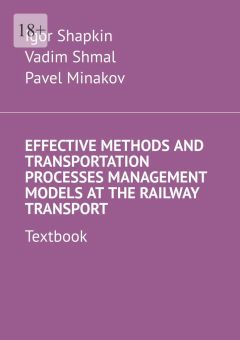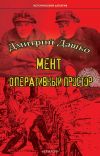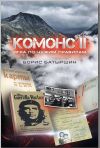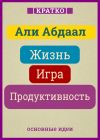Текст книги "Effective Methods and Transportation Processes Management Models at the Railway Transport. Textbook"

Автор книги: Igor Shapkin
Жанр: Прочая образовательная литература, Наука и Образование
Возрастные ограничения: +18
сообщить о неприемлемом содержимом
Текущая страница: 1 (всего у книги 11 страниц) [доступный отрывок для чтения: 2 страниц]
Effective Methods and Transportation Processes Management Models at the Railway Transport
Textbook
Igor Shapkin
Vadim Shmal
Pavel Minakov
© Igor Shapkin, 2023
© Vadim Shmal, 2023
© Pavel Minakov, 2023
ISBN 978-5-0060-7671-6
Created with Ridero smart publishing system
INTRODUCTION
In the country’s transport system, rail transport occupies a leading place in the development of the Russian economy. The most important role in the strategy for the development of railway transport in Russia belongs to the process of informatization, which provides the necessary and reliable information to all areas of management related to the transportation of goods and passengers. For fundamental scientific, technical and organizational problems solvation, the Concept and Program of Informatization of Railway Transport have been developed.
In the context of large-scale reforms in railway transport informatization is carried out using information technologies, the most important elements of which are models, methods and algorithms for making control decisions.
The problem of the development of the transport complex of Russia cannot be solved without the creation and improvement of a high-tech complex of interrelated formal models, applied methods and effective decision-making algorithms in the management of the transportation process.
An analysis of the current conditions for the functioning of railway transport shows that there are often problems for which the previously developed methodological tool turned out to be poorly adapted and the creation of a new generation of models and methods for making the right management decisions is required. The developed methods and models, on the one hand, should take into account the new functional requirements for information and control systems in railway transport, on the other hand, modern trends in the construction of these models, methods and algorithms.
The implementation of control decisions made on the basis of inadequate models and methods can lead to serious consequences, and the management problem that has arisen cannot be solved, even with a large amount of information, until an adequate model, method or algorithm is developed.
Today, in railway transport, there is a significant gap between the enormous capabilities of existing computers and the machine algorithms used for control decisions. There is a need for an early transition from the information to the control mode of transport management, the development of fundamentally new, more adequate and effective models, methods and algorithms to improve the objectivity, quality and timeliness of management decisions.
A special problem associated with the adaptation of the control system to the changed conditions and requiring a mandatory solution in the development of a new generation of methods and models is the issues of improving the structure of the control system. An effective approach to its solution, which makes it possible to better adapt to transportation management and significantly reduce the complexity of management, is the development of multi-level management structures through the optimal decomposition of the transport network into landfills. Of particular relevance is the problem of transition to polygon transportation management technologies. This technology is formed on the basis of scientific and technological achievements and provides for new solutions – the transition from regional management principles to the planning and organization of train traffic on the landfill network. Based on the fact that bulk cargo is mainly formed by enterprises of the Ural-Siberian region, their networks distinguish two enlarged landfills. This is the Eastern polygon, includes the Baikal-Amur Mainline and the Trans-Siberian Railway, and the Western, where the main cargo flows are concentrated in the direction of the North-West, the center and the South of the country.
Today, these areas account for more than 80% of the network cargo turnover with their total length of 28 thousand km, which is a third of the operational length of the network.
The key principle of the landfill is the technology and infrastructure parameters unification and the existing contradictions elimination at the borders. It is this approach that will allow you to achieve the maximum effect, including from investments.
A significant problem is the adequate models and methods development of discrete combinatorial optimization, since in the context of economic reforms, the role of discrete problems of managing transport systems increases. The importance of this problem is explained by the strengthening of the quality requirements and efficiency of solving those numerous control problems that are most consistent with the mathematics of discrete sets or sets that change at discrete moments of time.
The main problem of solving discrete control problems is exacerbated by four additional problems. Firstly, many of the problems under consideration are multi-criteria, which significantly complicates the search for the optimal solution, since it requires the determination of some compromise result, which in the general case is not optimal for any criterion. Secondly, it is necessary to take into account the significantly positive nature of a number of parameters of the management tasks to be solved, which will make it possible to build adequate models and methods that take into account the real capabilities of various elements of the transport network for the passage and processing of wagons and trains. Thirdly, the variable conditions of the network required the development of adequate dynamic models that take into account the non-stationary nature of the discrete control problems to be solved. Fourthly, the complexity of the ongoing reforms, the difficulty of identifying the main parameters of new management tasks and other reasons lead to the need to develop control decisions based on inaccurate, approximate and so-called «fuzzy» initial data, for which it is enough just to indicate their possible values relative to a certain interval of reliability.
The proposed book attempts to systematize the solutions to the above management problems based on the creation of appropriate models, methods and algorithms, which are an important part of promising information technologies that require priority implementation in railway transport and transport systems.
The authors hope that the book will help developers and students specializing in the field of transportation process management based on information technology to get acquainted with the methods of building and implementing models and methods of management in railway transport.
The book is aimed at students, graduate students and specialists interested in modern ideas of applying new models and methods of management in railway transport.
1 INFORMATIZATION AS A STRATEGIC COURSE FOR THE RAILWAY TRANSPORT RESTRUCTURING
Informatization of transport is an integral part of the society informatization national process associated with the production and widespread use of information as a special type of resource based on the transition to high-tech and knowledge-intensive methods of organizing transportation.
Informatization is based on the Concept and Program of Informatization of Railway Transport, which is a system of goals, objectives and main directions of informatization for a given period, priorities, means and ways to achieve the goals of informatization.
Information environment – information implemented in a databases and knowledge system, which ensures the functioning of objects, controls and individual users associated with transport. The ultimate goal of designing an information environment is to create a single transparent information space in which all interested users can be provided with the necessary and reliable information everywhere at the right time and in a convenient form.
The transport informatization infrastructure is designed to provide living conditions for the information environment and, first of all, its physical support and maintenance.
The second level of informatization representation is determined by its applied or user role, achieved by the formation of new information technologies.
New information technologies are a systemic concept that combines new high-tech and knowledge-intensive models and methods of transport management into a single whole, and provide the level of informatization represented by the information environment and infrastructure.
The changes in the methods of automated control of technological processes accumulated in recent years in railway transport, the priorities of the goals of functioning require new modern solutions aimed at reducing costs and increasing industry revenues.
In the context of the transition to a market economy, it is impossible to ensure the operation of railway transport without the use of new technologies, which, as world experience shows, are the most important means for the formation of a competitive, sustainable production and economic model of the transport system.
The introduction of new effective technologies that provide «breakthrough» directions of informatization is hampered by the lack of adequate scientifically based models and methods for solving the problems of railway transport management in the current and future periods of the industry’s functioning.
It is possible to develop new information technologies using the SADT methodology for describing complex systems and industries.
The most important product of designing new information technologies is mathematical models that allow you to understand the structure of the future system, balance requirements and build an effective management system.
The construction of mathematical models occupies a leading place among the problems of creating new methods, their development and management.
The infiltration of new management methods into railway transport follows the path of mathematical modeling of the corresponding objects. If an adequate model of the management system is built, then its study will make it possible to identify the bottlenecks and imperfections of the existing system, develop alternative options for its development and evaluate their effectiveness in terms of achieving the goals of the system and solving its main tasks. Currently, there are a large number of works by authors devoted to the problem of constructing mathematical models for managing transport systems and production. In these works, modeling works in any local area are usually considered using specific methodological tools of mathematical modeling.
This is due to the fact that there is no urgent need to build, coordinate and update integrated management models, since the local ones coped with their tasks quite well. Local modeling, as a rule, is based on any one type of model, which makes it possible to standardize the language for describing models and methods for their analysis
However, local modeling methods are not productive enough to describe large-scale enterprise systems such as rail transport.
The expressive capabilities of any particular variety of models are limited, making it adequate only for a limited field of application. The poor scalability of the developed models does not allow to flexibly and adequately describe the variety of aspects of the activities of systems, both small and large-scale.
The study methodological basis is based on a systemological approach. The development of a comprehensive modeling methodology is based on an architectural concept, frame theory and a variety of complementary types of models and methods.
A systemological approach to the development of large-scale software areas should meet the following basic conceptual requirements:
• ensure the design and development of new information technologies in strict accordance with the requirements for the management system;
• to form an adequate system of models that are functionally interconnected and coordinated in strict accordance with the goals of management systems;
• allow continuous research and improvement of information technologies based on systems and models;
• ensure the transition to new information technologies based on digital models and computing systems.
Modern computer technologies should provide new methodological capabilities, be considered through specific information technologies and the tools that support them; use a set of methodological tools that automate the basic processes of designing system solutions; ensure the construction of a single constantly evolving knowledge base, which should contain all the information about the model system; have formalized rules for the transition from analysis to design and vice versa; be visual and easy to learn.
Systemological paradigms represent the most significant attributes for further research purposes, the fundamental essence of the «systemological approach» under consideration.
«There is no branch of mathematics, even the most abstract, that cannot ever be applied to the real world.»
N.I. Lobachevsky
2 TRAFFIC MANAGEMENT MODERN MODELS
2.1 Subject and tasks of decision-making in railway transport
Tendencies of globalization of the economy predetermine the ever-increasing attention of science to the issues of organization and management.
The rapid development of informatization of technological processes, the complication of technology, the expansion of the scale of activities, the introduction of automated and intelligent control systems in all areas of practice – all this leads to the need for a scientific analysis of complex purposeful processes in terms of their structure and organization. Science is required to provide guidance on the optimal (correct) management of such processes.
The needs of practice have brought to life special scientific methods, which are usually combined under the general name «Operations Research».
Operations research refers to the use of mathematical, quantitative methods to justify decisions in all areas of purposeful human activity. Operations research is a kind of mathematical «application» to the future, which saves effort, time and material resources.
The more complex and expensive the organized event is, the less permissible «strong-willed» decisions are in it and the more important are scientific methods that allow us to assess the consequences of each decision in advance, discard unacceptable options in advance and recommend the most successful ones, allowing us to establish whether the information we have is sufficient for the correct choice of solution, and, if not, what information needs to be additionally obtained and worked out.
It is not uncommon for experience and common sense to rely on experience and common sense when choosing a solution when it comes to an event carried out for the first time. «Experience» in this case is silent, and «common sense» can easily deceive if it does not rely on calculation. Such mathematical calculations, which make it easier for people to make reasonable decisions, are engaged in the science of «operations research».
This is a relatively young science. For the first time this name appeared during the Second World War, in the armed forces of the United States and England.
In the future, the study of operations expanded the scope of application to a variety of sectors of the economy: industry, transport, agriculture, trade, healthcare, consumer services, nature protection.
A distinctive feature of the tasks of operations research is the presence of some kind of activity that pursues a specific goal. Some conditions are set that characterize the environment of the event (in particular, the means that we can dispose of). Within the framework of these conditions, it is required to make such a decision so that the conceived event is, in a sense, the most profitable (or most unprofitable).
In accordance with these general features, general methods for solving such problems are developed, which together constitute the methodological basis and apparatus for the study of operations.
We will give definitions, terminology and basic principles of this science.
An operation is any event (or system of actions) united by a single plan and aimed at achieving a goal.
The operation is a managed event, i.e. it depends on it to choose in one way or another some parameters that characterize its organization. «Organization» here is understood in the broad sense of the word (including the set of technical means used in the operation).
Any decisive choice of parameters that depend on it is called a decision. Decisions can be successful and unsuccessful, reasonable and unreasonable.
Optimal solutions are those that are preferable to others for one reason or another.
The purpose of operations research is a preliminary quantitative justification of optimal solutions.
Sometimes (relatively rarely) as a result of the study, it is possible to indicate a single, strictly optimal solution. Much more often there are cases – to highlight the area of almost equivalent optimal solutions, within which the final choice can be made. The decision-making itself goes beyond the scope of the operations study and falls within the competence of the responsible person, more often a group of persons who are given the right of final choice.
In this choice, they can take into account, along with the recommendations arising from the mathematical calculation, also a number of considerations (quantitative and qualitative) that were not taken into account by this calculation.
The indispensable presence of a person (as the final instance of decision-making) is not canceled even in the presence of a fully automated control system, which, it would seem, makes the optimal decision depending on the situation without human intervention. We must not forget that the very creation of the control algorithm, the choice of one of its possible options, is also a decision, and a very responsible one. With the development of ACS and ITS, human functions are not canceled, but simply move from one elementary level to another, higher.
The parameters that combine to form a solution are called solution elements. For example, if you plan to transport goods, the elements of the solution will be numbers that indicate how much cargo will be sent from each point of origin to each destination, the routes of the goods and the time of delivery.
In the simplest problems of operations research, the number of solution elements can be relatively small. However, in most tasks of practical importance, the number of elements of the solution is very large, which, of course, makes it difficult to analyze the situation and make recommendations. As a rule, any task of operations research results in a whole scientific study performed collectively, which takes a lot of time and requires the mandatory use of computer technology.
In addition to the elements of the solution, which we, within some limits, can dispose of, in any problem of operations research there are also given, «disciplining» conditions that are fixed from the very beginning and cannot be violated. In particular, such conditions include the means (material, technical, technological, human) that we have the right to dispose of, and various kinds of restrictions relying on solutions.
2.2 Mathematical modeling of operations
For the application of quantitative research methods in any field, some kind of mathematical model is always required. When constructing a mathematical model, a real phenomenon (in our case, an operation) is always simplified, schematized, and the resulting scheme is described using one or another mathematical apparatus. The more successfully the mathematical model is chosen, the better it will reflect the characteristic features of the phenomenon, the more successful the study will be and the more useful the recommendations arising from it.
There are no general ways to construct mathematical models. In each case, the model is selected based on the target orientation of the operation and the research task, taking into account the required accuracy of the solution and the accuracy with which we can know the initial data. If the initial data is known inaccurately, then, obviously, there is no point in building a very detailed, subtle and accurate model of the phenomenon and wasting time (your own and machine) on subtle and accurate optimization of the solution. Unfortunately, this principle is often neglected in practice and excessively detailed models are chosen to describe phenomena.
The model should reflect the most important features of the phenomenon, i.e. it should take into account all the essential factors on which the success of the operation most depends. At the same time, the model should be as simple as possible, not «clogged» with a mass of small, secondary factors, since taking them into account complicates mathematical analysis and makes the results of the study difficult to see. In a word, the art of making mathematical models is precisely the art, and experience in this matter is acquired gradually. Two dangers always lie in wait for the compiler of the model: the first is to drown in detail («you can’t see the forest because of the trees»); The second is to coarsen the phenomenon too much («throw out the baby with the bathwater»). Therefore, when solving problems of operations research, it is always useful to compare the results obtained by different models, to arrange a kind of «model dispute». The same problem is solved not once, but several, using different systems of assumptions, different apparatus, different models.
If scientific conclusions change little from model to model, this is a serious argument in favor of the objectivity of the study. If they differ significantly, it is necessary to revise the concepts underlying the various models, to see which of them is most adequate to reality. It is also characteristic of the operations study to re-refer to the model (after the study in the first approximation has already been performed) to make the necessary adjustments to this model.
The construction of a mathematical model is the most important and responsible part of the study, which requires deep knowledge not only and not so much of mathematics, but of the essence of the phenomena being modeled. As a rule, «pure» mathematicians do not cope with this task well without the help of specialists in this field. They focus on the mathematical apparatus with its subtleties, and not the correspondence of the model to the real phenomenon. Experience shows that the most successful models are created by specialists in this field of practice, who have received deep mathematical training in addition to the main one, or by groups that unite specialists and mathematicians.
The mathematical training of a specialist wishing to engage in the study of operations in his field of practice should be quite wide. Along with classical methods of analysis, it should include a number of modern branches of mathematics, such as optimization methods, including linear, nonlinear, dynamic programming, methods of machine search for extremes, etc. Special requirements for probabilistic training are related to the fact that most operations are carried out in conditions of incomplete certainty, their course and outcome depend on random factors – such as meteorological conditions, fluctuations in supply and demand, failures of technical devices, etc. Therefore, creative work in the field of operations research requires a good command of probability theory, including its newest sections: the theory of stochastic processes, information theory, theory of games and static solutions, theory of queuing.
When constructing a mathematical model, a mathematical apparatus of varying complexity can be used (depending on the type of operation and research tasks). In the simplest cases, the model is described by simple algebraic equations. In more complex ones, when it is necessary to consider the phenomenon in dynamics, the apparatus of differential equations, both ordinary and partial derivatives, is used. In the most difficult cases, if the development of the operation in time depends on a large number of intricately intertwined random factors, the method of statistical modeling is used. As a first approximation, the idea of the method can be described as follows: the process of development of the operation, as it were, is «copied», reproduced on a machine (computer) with all the accompanying accidents. Thus, one instance (one implementation) of a random process (operation) is built, with a random course and outcome. By itself, one such implementation does not give grounds for choosing a solution, but, having received a set of such implementations, we process them as ordinary statistical material (hence the term «statistical modeling»), derive the average characteristics for a set of implementations and get an idea of how, on average, the conditions of the problem and the elements of the solution affect the course and outcome of the operation.
In the study of operations, the course of which is influenced by random factors, the so-called «stochastic problems of operations research», both analytical and statistical models are used. Each of these types of models has its advantages and disadvantages. Analytical models are coarser than statistical ones, take into account fewer factors, and inevitably require some assumptions and simplifications. These models can describe the phenomenon only approximately, schematically, but the results of such modeling are more visual and more clearly reflect the patterns inherent in the phenomenon. And most importantly, analytical models are more suitable for finding optimal solutions, which can also be carried out by analytical methods, using all the means of modern mathematics.
Statistical models, in comparison with analytical ones, are more accurate and detailed, do not require such crude assumptions, and allow us to take into account a large (in theory, infinitely large) number of factors. It would seem that they are closer to reality and should be preferred. However, they also have their drawbacks: comparative bulkiness, high consumption of computer time; poor visibility of the results obtained and the difficulty of comprehending them. And most importantly, the extreme difficulty of finding the optimal solutions that have to be sought «by touch», by guesses and trials.
Young professionals, whose experience in operations research is limited, having at their disposal modern computers, often unnecessarily begin research with the construction of its statistical model, trying to take into account in this model a huge number of factors (the more, the better). As a result, many of these models remain «stillborn», since they have not developed a methodology for applying and comprehending the results, translating them into the rank of recommendations.
The best results are obtained when analytical and statistical models are used together. A simple analytical model allows you to understand the basic laws of the phenomenon, outline, as it were, its «contour», and indicate a reasonable solution in the first approximation. After that, any refinement can be obtained by statistical modeling. If the results of statistical modeling do not diverge too much from the results of analytical modeling, this gives us reason not only in this case, but also in many similar ones, to apply an analytical model. If the statistical model gives significantly different results compared to the analytical one, a system of corrections to the analytical solution can be developed such as «empirical formulas» that are widely used in technology.
When optimizing solutions, it can also be very useful to optimize them in advance on an analytical model. This will allow, when using a more accurate statistical model, to search for the optimal solution not quite at random, but in a limited area containing solutions that are close to the optimal ones in the analytical model. Given that in practice we are rarely interested in a single, exactly optimal solution, more often it is necessary to indicate the area in which it lies, analytical optimization methods, tested and supported by statistical modeling, can be a valuable tool for making recommendations.
The construction of a mathematical model of operations is not important in itself, but is aimed at identifying optimal solutions. It is advisable to choose a solution that ensures operations of maximum efficiency. Under the effectiveness of the operation, of course, the measure of its success is the degree of its adaptability to achieve the goal before it.
In order to compare various solutions in terms of effectiveness, it is necessary to have some kind of quantitative criterion, an indicator of effectiveness (it is often called the «target function»). This indicator is selected so that it best reflects the target orientation of operations. To choose a performance indicator, you must first ask yourself: what do we want, what do we strive for when undertaking an operation? When choosing a solution, we prefer one that turns the performance indicator into a maximum (or minimum).
Very often, the cost of performing operations appears as performance indicators, which, of course, need to be minimized. For example, if the operation aims to change the production technology so as to reduce the cost of production as much as possible, then it will be natural to take the average cost as an indicator of efficiency and prefer the solution that will turn this indicator into a minimum.
In some cases, it happens that the operation pursues a well-defined goal A, which alone can be achieved or not achieved (we are not interested in any intermediate results). Then the probability of achieving this goal is chosen as an indicator of effectiveness. For example, if you are shooting at an object with the sine qua non condition of destroying it, the probability of destroying the object will be an indicator of effectiveness.









































